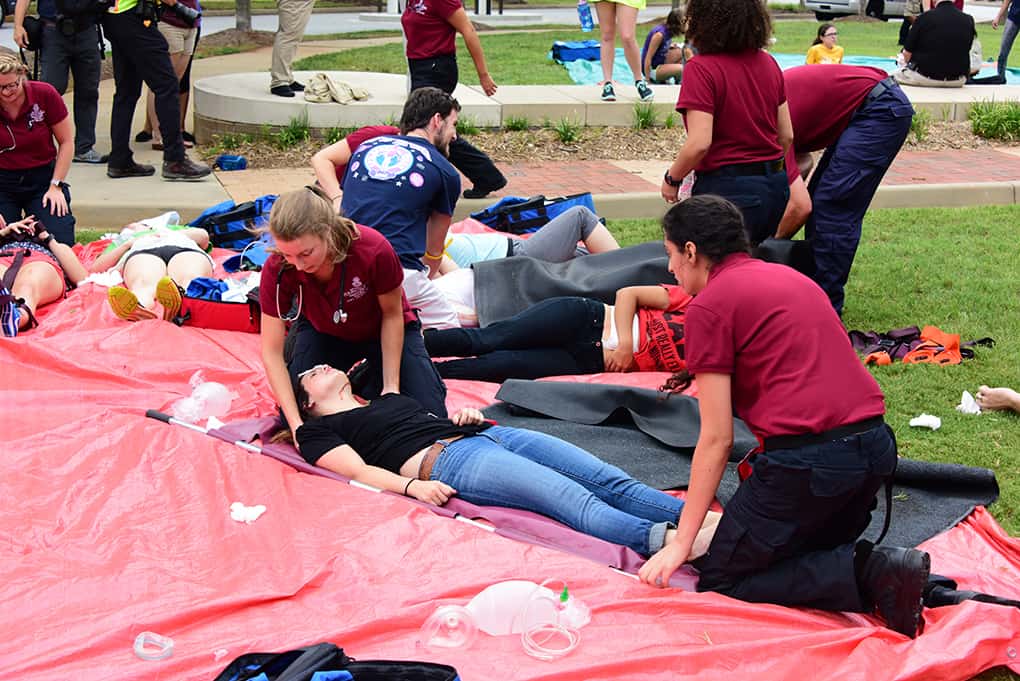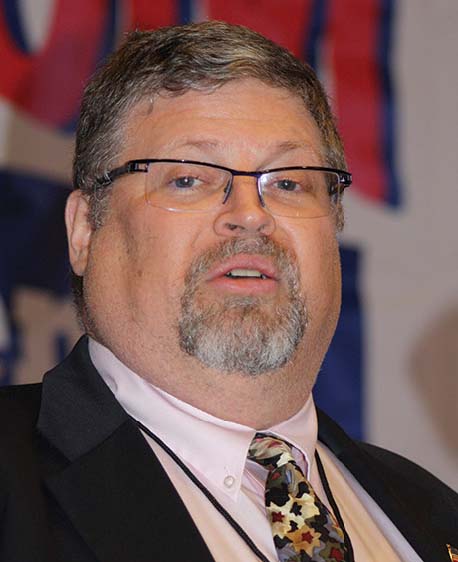
(from greenvillejournal.com)
[Ed: In our third and final presentation to the Gun Rights Policy Conference in Chicago on September 23, Dr. Edeen spoke about the preparations that need to be made for immediate, life-saving trauma intervention.]
Today I am going to talk about trauma medicine in schools. Rob Morse suggested this as a topic to explore.
Picture yourself standing next to the sink, washing the dishes after breakfast, when you get a notification that there is an active killer at your child’s school.
What is your school’s plan? Do they have a School Resource Officer? Are teachers or other staff armed? Or is their solution to lock down and wait for police to respond?
Eric Dietz, PhD, professor at Purdue University, did a computer simulation study. He looked at the casualty and response times in a school active killer event if there were no armed persons at the school, if there was a School Resource Officer, if 5% of teachers and faculty were armed, if 10% were, if there was a resource officer plus 5% of staff armed, and if there was a resource officer plus 10% of staff armed. He found there was a significant decrease in response time and number of casualties when armed people (especially resource officers) were prepared to defend.
I attended the Rangemaster Tactical Conference (TACCON) in March of 2018 and Ed Monk gave a talk on his study of mass murder events in recent history. He is a retired Army officer, law enforcement officer, firearms instructor and high school teacher. He found that, on average, there is one victim shot every ten seconds. If there is an armed person present who intervenes, the casualties are in single digits (0 to 9). If victims have to wait for armed law enforcement to arrive, the casualty count is in double to triple digits (17 to 102). Time is of the essence!
I contacted Joe Eaton of the FASTER program and he put me in contact with Cameron McElroy, who is an EMT. They talked to me about their program. FASTER stands for Faculty, Administrator, Safety Training and Emergency Response. They teach safe firearms handling and marksmanship training that exceeds the level required for their State Police. They also teach crisis management skills and trauma first aid. It’s unfortunate that this level of training has to be implemented within our schools, however, it is imperative that schools, offices, and campuses have access to this type of training to ensure that our children and family members are living and working within a safe environment. First aid is one of the most useful skills you can learn. In the US and Canada, first aid courses are offered to those who want to learn the skills of Basic Life Support. For example, Canadian institutions seek out courses similar to this CPR training course in London, Ontario. In the US, with the growing number of mass shootings, and school shootings appearing all over the country, it is necessary that we see schools train their faculty for any unexpected attacks. In some cases only knowing First Aid won’t do, however, paired with other skills, it can be a useful asset in the event of a mass shooting, so programs like FASTER are truly needed.
Their approach to trauma first aid is fashioned after Tactical Combat Casualty Care (TCCC), a course developed by the Special Forces and the military. The main emphasis is on stopping the bleeding, because if the bleeding doesn’t stop, nothing else matters. Then you have to open the airway, seal penetrating chest wounds and then evacuate the victim to safety and more advanced care.
The types of preventable deaths that we can treat are: extremity hemorrhage, junctional hemorrhage, tension pneumothorax and airway obstruction.
Massive extremity hemorrhage is most effectively controlled with a tourniquet. The two types of tourniquets approved by the Committee on Tactical Combat Casualty Care are the CAT and the SOFTT. The CAT tourniquet stands for Combat Application Tourniquet and the SOFTT stand for Special Operations Forces Tactical Tourniquet. These were both developed for military use. There is also a non-approved tourniquet that may be useful called the RATS tourniquet. In children, the approved tourniquets do not always fit. The RATS tourniquet can work for smaller children and animals. The third type of tourniquet is an improvised tourniquet. The FASTER program recommends a triangular bandage (cravat) with a dowel as a viable alternative.
Junctional hemorrhage pertains to bleeding coming from the pelvis, groin, axilla (armpit) or neck. Those are places where you cannot place a tourniquet. In these areas, it is necessary to pack the wound to stop the hemorrhage. QuikClot gauze is recommended. QuikClot gauze is impregnated with a chemical to stimulate clotting. It is recommended to pack the wound deeply and tightly, and to hold direct pressure for at least three minutes to stop the hemorrhage.
Tension pneumothorax results from a penetrating injury to the chest and a sucking chest wound. When you breathe in, air enters the chest cavity and prevents the lung from inflating. We treat this by sealing the wound with a chest seal. You can use a vented chest seal. It acts as a one-way valve to allow the air to escape, deflating the tension pneumothorax. If you have a pneumothorax that is not responding, it can be decompressed with a large bore needle. If you don’t decompress these, air continues to enter the chest cavity and can compress the heart leading to circulatory collapse.
If a person is conscious and able to talk to you, they do not have an airway obstruction and do not need treatment. If they are unconscious, place them in the recovery position (on their side). You can use a chin lift or jaw thrust to open the airway. An oropharyngeal or, better, nasopharyngeal airway can be placed to keep the tongue from occluding the airway. There are other types of airways that sit on top of the larynx (“extraglottic”). These are the laryngeal mask airway (LMA) and the I-gel. The recommended airway is the I-gel because the LMA holds air and expands while flying.
Does your school have a plan? Is the plan to call 911 and wait? Do they have School Resource Officers? Do they have armed and trained staff? Do they have adequate supplies? There are commercially available trauma kits. FASTER also sells kits on their website. And most importantly, are your staff trained in the use of life-saving emergency supplies?
You need to ask these questions of your principals, administrators and school boards. Every school should have these supplies readily available. The staff needs to be trained in their use and they must be available in an emergency.
 -Dr. John Edeen is a pediatric orthopedic surgeon in San Antonio, TX and is active in seeking the right to carry for qualified hospital staff. He is DRGO’s Membership Director.
-Dr. John Edeen is a pediatric orthopedic surgeon in San Antonio, TX and is active in seeking the right to carry for qualified hospital staff. He is DRGO’s Membership Director.
